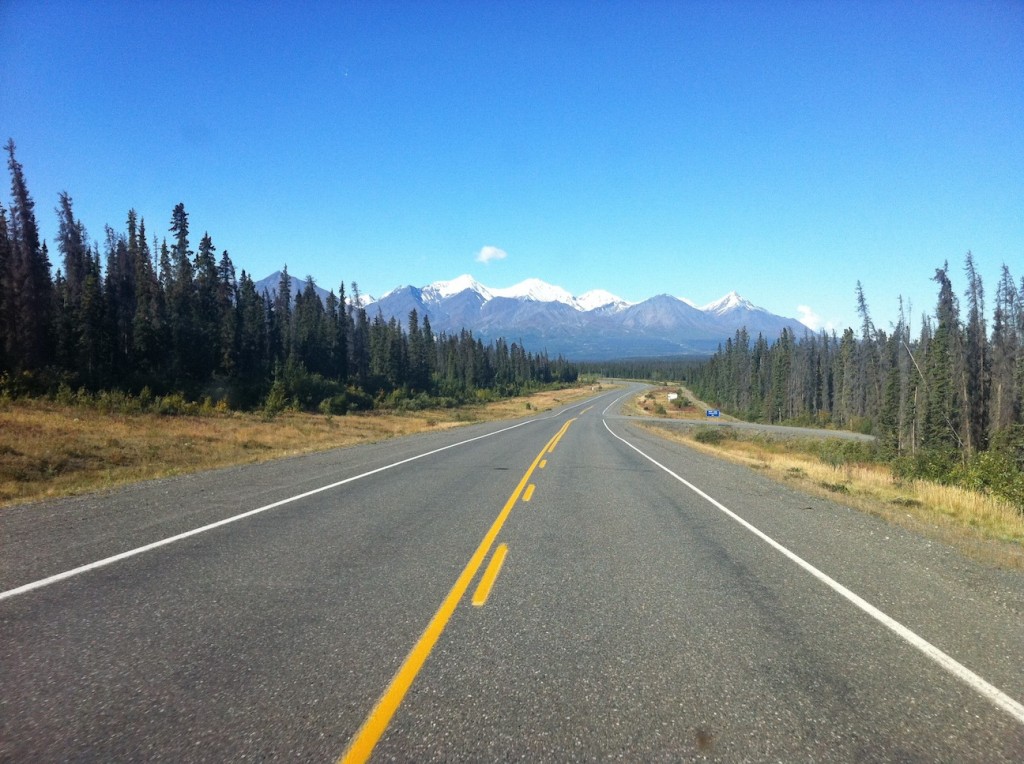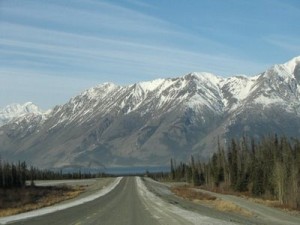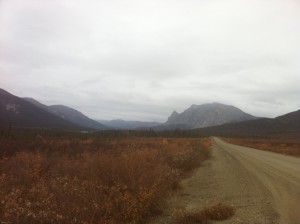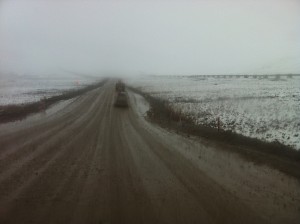So where were we? Oh yeah, Whitehorse, capital of the Yukon Territory, waiting to repair the semi-crippled Traipsemobile.
It wasn’t easy. The service department at the local Dodge dealer clamed to be booked solid for the next week. The local Freightliner shop had never even seen a Sprinter before and didn’t have any of the diagnostic tools (a tri-corder or something) necessary to figure out what was wrong. (The Traipsemobile, in case I haven’t made this clear, is a Mercedes/Dodge/Freightliner Sprinter and, theoretically, can be serviced at dealerships for any of those brands.) Parts, if we could determine which ones we’d need, would have to be ordered from Edmonton and would be at least a week in arriving. Possibly by mule train. It looked like I’d be in Whitehorse for a while.
Which was not a terrible thing. It’s a funky little town, with the aforementioned saloons and breweries (Yukon Brewing Company slogan: “Beer Worth Freezing For”) and coffee houses. It still feels like a Gold Rush town, which is how it began. The railroad from Skagway to Whitehorse made this the transit point for all those Klondike gold panners back in 1900 trying to get up to Dawson City. This was where they all got supplies or traded their nuggets for whiskey and whores. Half the people here still look like Gabby Hayes. And yes, there’s still gold in them thar hills.
There is also a shockingly good restaurant called Burnt Toast, which has an ever-changing menu, full of great odd-for-Canada entrees like Jambalaya. It’s cool and dark and stylish and wouldn’t seem out of place in Vancouver or San Francisco. I don’t know how they survive, especially during the winter. It’s an impressive place.
As is Metro Chrysler, Ltd, , the only Dodge dealership in the Yukon, where they took pity upon me and weaseled an appointment for the Traipsemobile four days early. More importantly, they didn’t break into convulsions of derisive laughter while informing me that the only problem was a loose turbo-connector hose, dangling in a way that should have been visible to any idiot with a flashlight, including me. They hooked it up, checked to see if anything else needed moron proofing, charged me almost nothing and sent me on my way.
I was still 600 miles from Fairbanks, with the roughest parts of the Alaska Highway ahead of me. After Whitehorse the mountains get steeper, the forests get thicker and the people get further apart. The further north you go, the more the pavement undulates, the inevitable byproduct of building a road over perma-frost and semi-tundra. Most of the time you’re fine, but every once in a while there’ll be a little orange sign with an arrow by the side of the road indicating a dip in the pavement by which they mean a great heaving sinkhole that, when hit at speeds exceeding 35 mph, will separate your butt from the driver’s seat, your hands from the steering wheel and, if you’re unlucky enough, your axles from your vehicle. Slowing down is highly advisable.
But this is the stuff I came for, that sense of being Truly Out There, hundreds of miles from other humans on a two-lane road that, if you follow it far enough, will take you to the Arctic Ocean. I mean, it’s not climbing Everest or diving the Great Barrier Reef or anything. It’s just driving. But there’s a purity of doing it for it’s own sake that I find simultaneously exhilarating and soothing. When people ask me, “Why are you doing this?” the answer is, really, that I don’t know. But it’s got something to do with this feeling that you can only get when the road stretches out in front of you, a thin ribbon to the horizon, leading to a place that you haven’t been before.
So, without planning on it, maybe because I was so relieved to be on the road again, I drove all day, past Sheep Mountain and Beaver Creek and Destruction Bay, looping around almost all of Kluane Lake, which is 40 miles long and part of a massive glacier-fed water system that runs through the St. Elias Mountains and contains the largest non-polar ice field in the world. It’s gorgeous. It’s hypnotic. It’s exactly what you expect driving to Alaska to be like.
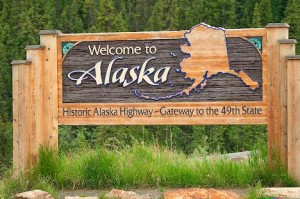 And I just kept going, past Burwash Landing, Snag Creek and Pickhandle Lake. Before I knew it, I was at the Alaska-Yukon border, a cinder-block building in the middle of nowhere where a bored-looking customs agent waved me through with barely a glance. I drove all the way to Fairbanks where I found the Blue Loon, a pub on the outskirts of town where they have blackened halibut and Arrogant Bastard on tap. There’s a big back room where they show movies and book live acts (including comedian Bob Zany, who I went back to see a week later. The opening acts were local morning deejays. They did jokes about duck migration.)
And I just kept going, past Burwash Landing, Snag Creek and Pickhandle Lake. Before I knew it, I was at the Alaska-Yukon border, a cinder-block building in the middle of nowhere where a bored-looking customs agent waved me through with barely a glance. I drove all the way to Fairbanks where I found the Blue Loon, a pub on the outskirts of town where they have blackened halibut and Arrogant Bastard on tap. There’s a big back room where they show movies and book live acts (including comedian Bob Zany, who I went back to see a week later. The opening acts were local morning deejays. They did jokes about duck migration.)
I’d driven 14 hours. It was nearly 10 p.m. And there was still light left in the sky.
Fairbanks was just a way station, a place to get clean and rested (There’s an Anytime Fitness there) before I took on the real challenge: The Dalton Highway to Prudhoe Bay, 400 miles of mostly-unpaved road that parallels the Alaska Pipeline all the way to the Arctic Ocean. Parts of it are gravel. Parts of it are dirt. A few miles – less than a hundred – are paved. Most of it, including everything north of the Yukon River, didn’t exist before 1975, when the Pipeline was built, and parts of it look pretty much like they just ran a bulldozer through the woods. The traffic is almost entirely supply trucks going back and forth to the Prudhoe Bay oil terminal and servicing the pipeline along the way. Tires and windshields don’t do well here. And there’s a stretch where there’s no fuel – or anything else – for 240 miles.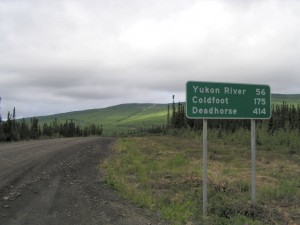
It was mid September and the weather was still spectacular in Fairbanks – 70 degrees in the day, mid 40’s overnight, no bugs, the Northern Lights just starting to appear in the sky. But Prudhoe Bay was another story. There had already been snow and 25-degree nights. If I was going that far north, 250 miles north of the Arctic Circle (and only 1200 miles from the North Pole) I needed to get there soon.
But not without a talisman. Even before I started living in the Traipsemobile, I’d decided that the minimum requirements for a successful journey would be driving as far north as possible – Prudhoe Bay – and then as far south as possible – The Panama Canal. Otherwise, I’d just be driving around aimlessly with no point whatsoever. (Shut up!)
Somehow – and I feel fairly certain this happened in a bar – I convinced myself that there ought to be a physical manifestation of this trek – something to focus on whenever I felt like I was just spinning my wheels, going nowhere in particular . (Shut up, some more!) Clearly, I needed something that could sit on the dashboard or hang from the rear view mirror.
What I needed was a vial, a container in which I could capture some water from the Arctic Ocean and then transport it to Panama where I could dump it in the Canal. And then, as foretold in the Ancient Manuscripts, the curse on humankind would be lifted and American Idol would be no more. Either that or the oceans start to boil. That’s a chance I’m willing to take.
I looked at assorted amulets and medical vials and perfume bottles, even test tubes, before buying a vintage dresser bottle from a Fairbanks antique store. I paid $50, which seems like a small price for – one way or the other – changing the world. It comes with a bone-colored holder, suitable for dashboard gluing. Perfect.
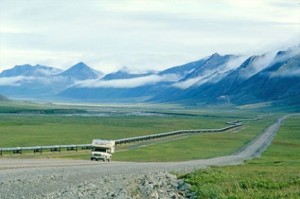 Since it was mid-September, I was something of a curiosity in Fairbanks. Most of the tourists were already gone. The restaurants were empty, places were beginning to shut down for the year. So a lot of people asked me why I was there. I told them I was driving to Prudhoe Bay and, more than once, they’d call out to someone else in the room, “Hey, this guy’s gonna drive the Haul Road.” And then they’d start to laugh.
Since it was mid-September, I was something of a curiosity in Fairbanks. Most of the tourists were already gone. The restaurants were empty, places were beginning to shut down for the year. So a lot of people asked me why I was there. I told them I was driving to Prudhoe Bay and, more than once, they’d call out to someone else in the room, “Hey, this guy’s gonna drive the Haul Road.” And then they’d start to laugh.
Really? Can it be that bad? Am I nuts for trying? People drive up there in cars and RV’s all the time. And it is an actual road, right? It’s not like I’m going in the dead of winter when it’s 70 below and the wolves just hang out by the side of the road, waiting for you to die.
Yes, it is the road on recent seasons of “Ice Road Truckers”, where they’re constantly showing video re-creations of semis sliding off of cliffs and drivers blinded by ice fog, careening into frozen bogs never to be heard from again. I’ve been on the set of Ice Road Truckers, back when the show was about actual Ice Roads, guys driving over frozen rivers and lakes and OCEANS. I went with them 25 miles off shore onto the Beaufort Sea. I saw 12-foot waves frozen solid. It looked like Superman’s Fortress of Solitude up there.
But the Dalton Highway (the Haul Road’s official name) is an actual, navigable road, not a frozen ocean. And I know how those tv guys like to exaggerate. The ugly truth about Ice Road Truckers is that, except for the fact that it’s cold as fuck, there’s not much real danger out there. The ice is 30 feet thick and the trucks are so big and heavy that they rarely slide anywhere. That’s why the footage of a truck crashing through the ice is computer-generated,; because in real life, it almost never happens. It’s tv bullshit. (Unlike “Deadliest Catch.” Those guys are the real deal. No exaggeration required.)
But back to the haul road: The first part was easy. The Dalton doesn’t officially start until Livengood, 85 miles north of Fairbanks, which is where the pavement ends. (In case you’re an idiot, there’s a sign that says “PAVEMENT ENDS.”) And it’s pretty much gravel from there on, nicely graded for a while. You could go 45-50 miles an hour. Which I did.
Aspen, poplars and spruce crowd the road and, because it was already fall in Alaska, the colors were mind-blowingly bright. The mountains looked like tapestries, all red and yellow. And not just regular yellow. Radioactive, industrial spray-paint yellow. It was like that bad fake-forest wallpaper that used to be in your orthodontist’s office. Only it was real. And smelled better.
The road gets rougher the further north you go and the landscape changes with every river crossing. The Yukon River, 55 miles into the drive, was unbridged before 1974 and the pipeline is suspended across it, running parallel to the “highway.” It’s another 60 miles to the Arctic Circle from there and 60 from there is “Coldfoot” which is the last official “town” in that it has a trailer-park motel, a diner and a gas station. Diesel is $5.29 a gallon and has been since last spring. Market fluctuations don’t matter much up here.
Past Coldfoot, the potholes get bigger, the gravel less evenly graded.. Also it was raining, then sleeting, then snowing, which means the whole thing was a gelatin-slick mud puddle. The Traipsemobile was suddenly two-tone, brown almost to the roof. Until a few years ago, private vehicles weren’t allowed up here without a special permit. I was beginning to see why.
The ugliest part was Atigun Pass, which is the highest pass in Alaska (4800 feet) and a favorite drama-point for Ice Road Truckers, who love to show 18-wheelers stalling on the 12 percent grade or teetering on the edge of the no-guard-rail hairpin turns. They tell you not to look down. It’s impossible not to look down.
I will admit that, for the first time on the trip, I was really scared. The Traipsemobile hadn’t been in real snow before (there was about 6 inches at the top of the pass), visibility was awful and climbing a mountain pass covered in slush is never any fun. Also, it was 25 degrees.
I kept crawling along and eventually got out of the snow and across the Brooks Range. The weather was still crap – rain and sleet mostly – there were a couple of places where I thought the Traipsemobile would surely get stuck in the mud. After which, I’d be raped by a Yeti.
But none of these things happened and somehow I made it out of the mountains and onto the long endless tundra that stretches to the Ocean. There are no trees up here. No mountains. Just me and the pipeline. And an occasional herd of musk ox.
By the time I gave up for the night – completely brain-fried – I was still 150 miles from Prudhoe Bay or, actually, Deadhorse, the company town that surrounds the oil terminal and beyond which civilians cannot pass. My plan, if I could get there in time, was to take the last authorized shuttle bus of the year – there wouldn’t be another one until next spring – to the Arctic Ocean, where I would scoop up the ocean water and then, uh, go back the way I came. (No, seriously, Shut Up!)
I slept in a turnoff, just off the highway, pointed towards the pipeline. A truck would whiz by every hour or so. Other than that, it was completely silent. And, for a change, so was I.
